
Break in your brand new calendar with these upcoming events and workshops.
Feast of the Baptism of the Lord
Sunday, January 9
After the Feast of the Baptism of the Lord, Ordinary Time begins. Thus, the Masses for this day as well as the environment and music still should contain elements of the Christmas season.
Catechumenate Support Group
Thursday, January 13, 12:30p - 2:30p
Chancery Offices, 4th floor, Education Department
900 Lafayette Street, Santa Clara
The Catechumenate Support Group meets every other month and is open for all who have responsibility for initiation of adults and children.
Free, bring your own lunch.
For more information: Diana Macalintal, 408-983-0136 or
Macalintal@dsj.org.
Creating Sacred Space Workshop
Thursday, January 13, 7p - 8:30p
St. Martin of Tours Church
200 O'Connor Drive, San Jose
Learn how to create an appropriate space for prayer in almost any setting. Participants will learn four basic elements that go into preparing an environment for prayer. This workshop is especially suited for those who facilitate small faith groups and lead prayer at group meetings.
Free, registration required.
To register: Sandra Pacheco, 408-983-0126 or
Pacheco@dsj.org.
Week of Prayer for Christian Unity
Tuesday, January 18 - Tuesday, January 25
Pope John Paul II calls the Catholic Church to join with all Christian churches to pray for the unity of all who believe in Christ. For Sunday, January 23, Bishop McGrath encourages parishes to use the prayers of "Masses and Prayers for Various Needs and Occasions - For Unity of Christians" found in the Sacramentary or of "Eucharistic Prayer for Masses for Various Needs and Occasions: I. The Church on the Way to Unity." Click
here for more information as well as liturgical resources, such as an ecumenical worship service, intercessions, and an eight-day biblical reflection.
Cantor Workshop
Tuesday, January 25, 7p - 9p
St. Simon Church
1860 Grant Road, Los Altos
Learn basic cantoring skills and singing techniques. In this master-class style workshop, some participants will have the chance to cantor a psalm and receive immediate feedback. If you would like to be one of the cantors at the workshop, please bring a copy of your psalm for the accompanist.
Free, registration required; please indicate if you would like to cantor at the workshop.
To register: Suzanne Fitzgerald, 650-967-8311,
Litmusic@aol.com. Click
here for a flyer you can print.
Ongoing Professional Education Series
Thursdays, January 27, February 3, and February 10, 9:30a - 12p
Transfiguration Church
4235 Jarvis Road, San Jose
Let’s Get Comfortable with the “E” Word: Catholic Evangelization in the 21st Century is a 3-part workshop series led by Fr. Keenan Osborne, OFM. All ecclesial lay ministers of the diocese are welcomed.
$20 total for pre-registration; $10 each session at the door.
To register: Iracema Gurbiel, 408-983-0127,
Gurbiel@dsj.org. Click
here for a registration form you can print.
Vino & Vespers
Friday, January 28, 7:30p - 9p
Villa Holy Names Spirituality Center
82 Prospect Avenue, Los Gatos
Spend an informal evening sharing prayer, intimate conversation, and good food. Our guest speaker is Tom Beaudoin.
Free will donation; registration required; adults over 21 only.
To register: Diana Macalintal, 408-983-0136 or
Macalintal@dsj.org. Click
here for a flyer you can print.
Liturgical Coordinators' Gathering
Tuesday, February 1, 10a - 12p
St. Nicholas Church
473 Lincoln Avenue, Los Altos
If you are responsible for preparing the liturgy for your parish, you're invited to gather with other liturgists and coordinators to discuss current issues in liturgy.
Free. RSVPs appreciated.
To RSVP: Sandra Pacheco, 408-983-0126 or
Pacheco@dsj.org.
Diocesan 25th and 50th Wedding Anniversary Mass
Saturday, February 5, 10a - 11:30a
Cathedral Basilica of St. Joseph
80 South Market Street, San Jose
Bishop Patrick McGrath invites all married couples celebrating 25th or 50th (or more) wedding anniversaries to a special diocesan bilingual Mass at the Cathedral.
Free; registrations required.
To register: Sylvia Blanch, 408-983-0126 or
Blanch@dsj.org. Click
here for a registration form you can print.
Rehearsal for Rite of Election
Monday and Tuesday, February 7 and 8, 7p - 8p
Cathedral Basilica of St. Joseph
80 South Market Street, San Jose
There will be two rehearsals for the Rite of Election. At least two people from your parish must attend one of the rehearsal (the catechumenate director may be one of the following persons):
one person to carry your Book of the Elect, and one (or two) people to read your names of the Elect. There is free parking on the street and public lots after 6p.
For more information: Diana Macalintal, 408-983-0136 or
Macalintal@dsj.org. Click
here for more information and for reservation forms for your catechumens.
Ash Wednesday
Wednesday, February 9
This begins the season of Lent and is a day of fast and abstinence. Click
here for the day's readings.
First Sunday of Lent
Sunday, February 13
Make sure you celebrate the Rite of Sending this weekend for any of your catechumens who are ready to be baptized. Click
here for the day's readings.
Rite of Election
Monday, Tuesday, and Wednesday, February 14, 15, and 16, 7:30p - 9p
Cathedral Basilica of St. Joseph
80 South Market Street, San Jose
This is the turning point for those adults who are seeking to become baptized. Those who are deemed ready for the Easter sacraments of baptism, confirmation, and Communion will be declared "the Elect" by Bishop McGrath at this rite. All are welcomed to participate. Read more about becoming Catholic
here.
For more information: Diana Macalintal, 408-983-0136 or
Macalintal@dsj.org.
FILED UNDER: WORKSHOPS AND EVENTS

 Christopher Citti of
Christopher Citti of 

 This article by Diana Macalintal first appeared in
This article by Diana Macalintal first appeared in  This article by Diana Macalintal first appeared in
This article by Diana Macalintal first appeared in  In his letter inaugurating the Year of the Eucharist, Pope John Paul II reminds us to begin at the end:
In his letter inaugurating the Year of the Eucharist, Pope John Paul II reminds us to begin at the end:
 My father lived most of his life on a beach. Once I visited his hometown in the Philippines and climbed up a ladder into a small beach hut on stilts made of bamboo shoots and banana leaves where a cousin I just met taught me to play chess. Every day my father and my brother would wade out into the ocean, and I would watch from the hut, never once venturing out into the water even though the days were mild and the ocean calm.
My father lived most of his life on a beach. Once I visited his hometown in the Philippines and climbed up a ladder into a small beach hut on stilts made of bamboo shoots and banana leaves where a cousin I just met taught me to play chess. Every day my father and my brother would wade out into the ocean, and I would watch from the hut, never once venturing out into the water even though the days were mild and the ocean calm.
 This Sunday, we end our Christmas season in water. California is right now being blasted with the second major storm of the winter, and the liturgical calendar places Jesus in the middle of the Jordan river. The silent night of Christmas has become a tempest and the child in a manger is now a man on mission. Perhaps nature and the liturgical calendar are conspiring to teach us a deeper meaning of Christmas. As comforting as the nativity scene is, as safe as the beach feels, as warm as our beds are on blustery winter mornings, we can’t stay there. The Christ cannot remain a baby in our religious imaginations, we can no longer take for granted the force of water to change our world, and we cannot simply retreat back into our “usual” pre-Christmas routine as though the Incarnation had been just a “time out” from our normal lives.
This Sunday, we end our Christmas season in water. California is right now being blasted with the second major storm of the winter, and the liturgical calendar places Jesus in the middle of the Jordan river. The silent night of Christmas has become a tempest and the child in a manger is now a man on mission. Perhaps nature and the liturgical calendar are conspiring to teach us a deeper meaning of Christmas. As comforting as the nativity scene is, as safe as the beach feels, as warm as our beds are on blustery winter mornings, we can’t stay there. The Christ cannot remain a baby in our religious imaginations, we can no longer take for granted the force of water to change our world, and we cannot simply retreat back into our “usual” pre-Christmas routine as though the Incarnation had been just a “time out” from our normal lives.
 Break in your brand new calendar with these upcoming events and workshops.
Break in your brand new calendar with these upcoming events and workshops.

 Many times, we need to prepare prayer for small groups or classes, and we don't always have the church building or chapel available. How do you make a classroom, living room, or parish hall a place where prayer can happen well?
Many times, we need to prepare prayer for small groups or classes, and we don't always have the church building or chapel available. How do you make a classroom, living room, or parish hall a place where prayer can happen well?
 Easter and Christmas are like two sides of a coin. The sights and sounds of one remind us of the smells and bells of the other. Theologically, one can say that the saving work of Christ’s resurrection and ascension began with his incarnation and, if we recall John’s Gospel on Christmas day, with creation itself.
Easter and Christmas are like two sides of a coin. The sights and sounds of one remind us of the smells and bells of the other. Theologically, one can say that the saving work of Christ’s resurrection and ascension began with his incarnation and, if we recall John’s Gospel on Christmas day, with creation itself.
 Let’s face it. Some of our Christmas songs are clichéd, trite and a bit too “sweet.” Yet our musical tradition is full of carols and hymns that, in the words of Environment and Art in Catholic Worship 21, are “capable of bearing the weight of mystery, awe, reverence and wonder which the liturgical action expresses.” Here are some of those songs.
Let’s face it. Some of our Christmas songs are clichéd, trite and a bit too “sweet.” Yet our musical tradition is full of carols and hymns that, in the words of Environment and Art in Catholic Worship 21, are “capable of bearing the weight of mystery, awe, reverence and wonder which the liturgical action expresses.” Here are some of those songs.
 Don't be chicken! You can become a better cantor! Learn the basics that will improve your singing technique and your leadership skills, and practice the habits that will make you a better leader of musical prayer. Some participants will have the opportunity to cantor and receive immediate feedback.
Don't be chicken! You can become a better cantor! Learn the basics that will improve your singing technique and your leadership skills, and practice the habits that will make you a better leader of musical prayer. Some participants will have the opportunity to cantor and receive immediate feedback. 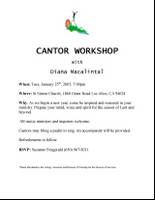
 Married couples celebrating 25th or 50th (or more) wedding anniversaries are invited to celebrate with Bishop Patrick McGrath at the Diocesan Silver and Golden Wedding Anniversary Mass on Saturday, February 5, 2005, 10:00 a.m., at the Cathedral Basilica of St. Joseph (80 South Market Street, San Jose). Reservations are requred. For information and to register, call: Sylvia Blanch, 408-983-0128 or
Married couples celebrating 25th or 50th (or more) wedding anniversaries are invited to celebrate with Bishop Patrick McGrath at the Diocesan Silver and Golden Wedding Anniversary Mass on Saturday, February 5, 2005, 10:00 a.m., at the Cathedral Basilica of St. Joseph (80 South Market Street, San Jose). Reservations are requred. For information and to register, call: Sylvia Blanch, 408-983-0128 or 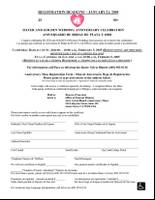
 Come have one last pre-Lenten bash the way only liturgists can--by talking about liturgy! If you coordinate the liturgy, you are invited to gather with others who know your joys and hopes, your fears and tribulations, your long hours for the sheer love of it all.
Come have one last pre-Lenten bash the way only liturgists can--by talking about liturgy! If you coordinate the liturgy, you are invited to gather with others who know your joys and hopes, your fears and tribulations, your long hours for the sheer love of it all.
 Sue Schuttinger, a catechetical and liturgical leader in our Diocese, was on her way to visit her son who is in the Peace Corps in Thailand when the tsunami hit. Neither of them were directly affected by the wave, but both have witnessed first hand the sacrificing love of the Thai people for those who have suffered. Below is Sue's email about her experience.
Sue Schuttinger, a catechetical and liturgical leader in our Diocese, was on her way to visit her son who is in the Peace Corps in Thailand when the tsunami hit. Neither of them were directly affected by the wave, but both have witnessed first hand the sacrificing love of the Thai people for those who have suffered. Below is Sue's email about her experience.


 Though we are sad to say goodbye to Rebeca Aldaz who served as secretary for the liturgy office for so many years, we are happy to welcome Sandra Pacheco who has accepted the job in the Office of Pastoral Ministry (OPM). She will bring some great skills and energy to this position. She also comes highly recommended by two pastors and one of our associates in OPM. She has volunteered at St. Maria Goretti and Second Harvest Food Bank. She has her BS in Business Administration with a concentration in Finance and is completely bilingual in English and Spanish. So when you call the liturgy office, you'll hear a new voice on the line and you'll be in good hands. You can reach Sandra at 408-983-0126 or
Though we are sad to say goodbye to Rebeca Aldaz who served as secretary for the liturgy office for so many years, we are happy to welcome Sandra Pacheco who has accepted the job in the Office of Pastoral Ministry (OPM). She will bring some great skills and energy to this position. She also comes highly recommended by two pastors and one of our associates in OPM. She has volunteered at St. Maria Goretti and Second Harvest Food Bank. She has her BS in Business Administration with a concentration in Finance and is completely bilingual in English and Spanish. So when you call the liturgy office, you'll hear a new voice on the line and you'll be in good hands. You can reach Sandra at 408-983-0126 or  The Diocese of San José will once again honor liturgical ministers of our parishes who qualify for the annual Pope Paul VI Award (learn more about Pope Paul VI
The Diocese of San José will once again honor liturgical ministers of our parishes who qualify for the annual Pope Paul VI Award (learn more about Pope Paul VI 
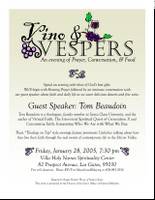

 Every year throughout the world since 1988, December 1st is set aside as a time to remember those who have died from AIDS, to keep in mind those who live with HIV, and to re-commit our efforts to finding a cure. According to the
Every year throughout the world since 1988, December 1st is set aside as a time to remember those who have died from AIDS, to keep in mind those who live with HIV, and to re-commit our efforts to finding a cure. According to the  Bishop Patrick McGrath invites all people of faith to gather together for a diocesan Evening Prayer for Peace. In this bilingual evening prayer, we will give thanks for Christ’s gift of peace and pray that there will be peace in our day especially in places of war. We will also offer prayers for those who have died, especially those who served as military, aid, and service workers in Iraq, Afghanistan, and other places of conflict. For more information, contact Diana Macalintal at
Bishop Patrick McGrath invites all people of faith to gather together for a diocesan Evening Prayer for Peace. In this bilingual evening prayer, we will give thanks for Christ’s gift of peace and pray that there will be peace in our day especially in places of war. We will also offer prayers for those who have died, especially those who served as military, aid, and service workers in Iraq, Afghanistan, and other places of conflict. For more information, contact Diana Macalintal at .1.jpg)
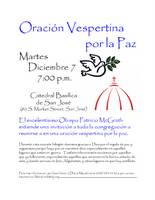
 2004 marks the 150th Anniversary of the Proclamation of the Dogma of the Immaculate Conception of Our Lady. This teaching professes that from the moment of Mary’s conception, she was free from original sin, preparing her to become the Mother of God, the “God-Bearer” or Theotokos. (Don't forget that the Immaculate Conception is about Mary being conceived from the union of her parents, Anna and Joachim.)
2004 marks the 150th Anniversary of the Proclamation of the Dogma of the Immaculate Conception of Our Lady. This teaching professes that from the moment of Mary’s conception, she was free from original sin, preparing her to become the Mother of God, the “God-Bearer” or Theotokos. (Don't forget that the Immaculate Conception is about Mary being conceived from the union of her parents, Anna and Joachim.)
 Every year, the diocese celebrates the feast of Our Lady of Guadalupe with processions and evening prayer in Spanish. This year's celebration takes place on Friday, December 10, 2004 at Our Lady of Guadalupe Church (
Every year, the diocese celebrates the feast of Our Lady of Guadalupe with processions and evening prayer in Spanish. This year's celebration takes place on Friday, December 10, 2004 at Our Lady of Guadalupe Church (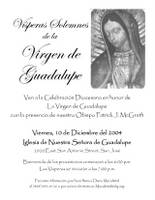

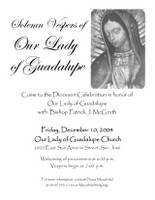

 The Season of Advent has a twofold character, a double meaning. Advent prepares us for Christmas, the celebration of Christ’s first coming to us, and it also reminds us to direct our minds and hearts to be prepared for Christ’s second coming at the end of time. In Christian usage the word “advent” (adventus) has a special liturgical significance, but the origin of the word is pagan.
The Season of Advent has a twofold character, a double meaning. Advent prepares us for Christmas, the celebration of Christ’s first coming to us, and it also reminds us to direct our minds and hearts to be prepared for Christ’s second coming at the end of time. In Christian usage the word “advent” (adventus) has a special liturgical significance, but the origin of the word is pagan.
 De-Clutter your church to let its primary purpose shine through
De-Clutter your church to let its primary purpose shine through
 The primary purpose of the sanctuary area is for the presidency of the assembly’s worship, the proclamation of God’s Word, and the celebration of the Eucharist. Therefore, the primary objects that should be prominent in this area are the altar, the ambo, and the presider’s chair. Everything else is secondary. Remove extraneous tables and chairs. Put only the altar cloth, corporal, bread and wine, and Sacramentary on the altar. Do not put water glasses for the presider, papers with Mass announcements or intentions, candles or flowers, or envelopes with Mass stipends or prayers on the altar. If the presider needs water, use a side table. Mass announcements or intentions should be in the bulletin or in the presider’s or commentator’s binder. Candles and flowers should be freestanding, placed away from the altar so that the celebrant, deacon, and other ministers can easily prepare the cups and plates for Communion without twisting around candle and flower stands. Also, be careful that the placement of decorations does not act as an altar rail, dividing the “holy space” from the “not holy space.” Envelopes with Mass intentions are seen most visibly during November when the dead are remembered. It is good to remember the dead, but do not place these envelopes, no matter how nicely decorated with ribbon, on top of the altar. This looks too much like our medieval practice of purchasing indulgences. If you want to display these envelopes, put them with the Book of the Dead, or at the baptismal font, on in the shrine of your parish patron saint.
The primary purpose of the sanctuary area is for the presidency of the assembly’s worship, the proclamation of God’s Word, and the celebration of the Eucharist. Therefore, the primary objects that should be prominent in this area are the altar, the ambo, and the presider’s chair. Everything else is secondary. Remove extraneous tables and chairs. Put only the altar cloth, corporal, bread and wine, and Sacramentary on the altar. Do not put water glasses for the presider, papers with Mass announcements or intentions, candles or flowers, or envelopes with Mass stipends or prayers on the altar. If the presider needs water, use a side table. Mass announcements or intentions should be in the bulletin or in the presider’s or commentator’s binder. Candles and flowers should be freestanding, placed away from the altar so that the celebrant, deacon, and other ministers can easily prepare the cups and plates for Communion without twisting around candle and flower stands. Also, be careful that the placement of decorations does not act as an altar rail, dividing the “holy space” from the “not holy space.” Envelopes with Mass intentions are seen most visibly during November when the dead are remembered. It is good to remember the dead, but do not place these envelopes, no matter how nicely decorated with ribbon, on top of the altar. This looks too much like our medieval practice of purchasing indulgences. If you want to display these envelopes, put them with the Book of the Dead, or at the baptismal font, on in the shrine of your parish patron saint.

 After 14 years as the administrative assistant for the liturgy office of the diocese (and many other offices in the chancery), Rebeca Aldaz is giving up her 80 mile daily commute between Gilroy and Santa Clara to serve her parish of St. Mary in Gilroy.
After 14 years as the administrative assistant for the liturgy office of the diocese (and many other offices in the chancery), Rebeca Aldaz is giving up her 80 mile daily commute between Gilroy and Santa Clara to serve her parish of St. Mary in Gilroy.